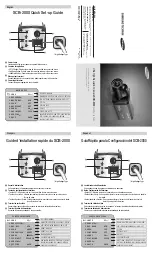
5
Figure 4 - Fall Clearance
A
Connecting Subsystem
(Energy Absorbing Lanyard shown)
B
Working Level
C
Lower Level or Obstruction
D Free Fall = 6 ft. (1.8 m) Max.
(per ANSI Z359.1)
E
Deceleration Distance
F
Total Fall Distance =
Free Fall (D) + Deceleration (E)
A
B
C
D
E
F
2.4 SWING
FALLS: Swing falls occur when the anchorage point is not directly
above the point where a fall occurs. The force of striking an object in
a swing fall may cause serious injury or death. Minimize swing falls by
working as close to the anchorage point as possible. Do not permit a swing
fall if injury could occur. Swing falls will signifi cantly increase the clearance
required when a self- retracting lifeline or other variable length connecting
subsystem is used.
2.5 EXTENDED
SUSPENSION: A full body harness is not intended for use in
extended suspension applications. If the user is going to be suspended
for an extended length of time it is recommended that some form of seat
support be used. DBI-SALA recommends a seat board, suspension work
seat, seat sling, or a boatswain chair. Contact Capital Safety for more
information on these items.
Figure 5 - Swing Falls
2.6 ENVIRONMENTAL
HAZARDS: Use of this equipment in areas with environmental hazards may require
additional precautions to prevent injury to the user or damage to the equipment. Hazards may include,
but are not limited to; heat, chemicals, corrosive environments, high voltage power lines, gases, moving
machinery, and sharp edges.
2.7 COMPATIBILITY OF COMPONENTS: Unless otherwise noted, DBI-SALA equipment is designed for use with
DBI-SALA approved components and subsystems only. Substitutions or replacements made with non approved
components or subsystems may jeopardize compatibility of equipment and may affect safety and reliability of the
complete system.
2.8 COMPATIBILITY OF CONNECTORS: Connectors are considered to be compatible with connecting
elements when they have been designed to work together in such a way that their sizes and shapes do not
cause their gate mechanisms to inadvertently open regardless of how they become oriented. Connectors
(hooks, carabiners, and D-rings) must be capable of supporting at least 5,000 lbs. (22 kN). Connectors
must be compatible with the anchorage or other system components. Do not use equipment that is not
compatible. Non-compatible connectors may unintentionally disengage (see Figure 6). Connectors must
be compatible in size, shape, and strength. Self-locking snap hooks and carabiners are required by ANSI
Z359.1 and OSHA.
2.9 MAKING
CONNECTIONS: Use only self-locking snap hooks and carabiners with this equipment. Only use
connectors that are suitable to each application. Ensure all connections are compatible in size, shape and
strength. Do not use equipment that is not compatible. Ensure all connectors are fully closed and locked.






































